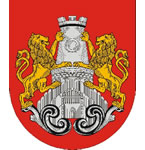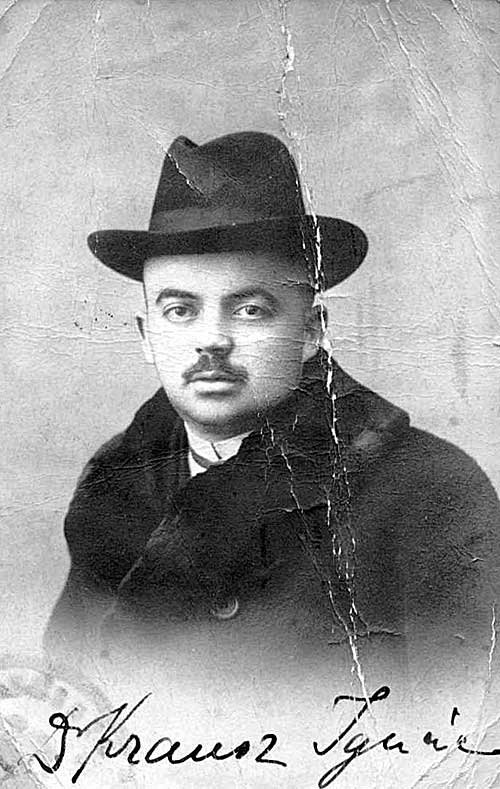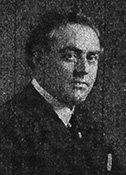 |
| Coat
of arms of Körmend |
This region was once a province of the Roman
Empire. Excavations in and around the town have
uncovered a Roman military fort. Körmend is
first mentioned in documents in 1238 by the name
"Villa Curmend terra regis" as a royal estate.
In 1244, King Bela IV granted Körmend a town
charter.
By
1300, Jews enjoying equal rights were present in
Körmend. Jews of Spanish origin may have
settled in Körmend by the late 16th century.
During the Renaissance under King Matyas, significant Jewish trade centers sprang up in most of the country's towns, particularly in the western half of what is now modern Hungary, including Sopron, Köszeg, Körmend, Szombathely, Sárvár, Gyõr, Komárom, Tata, Esztergom, Székesfehérvár, Papa, Kanizsa and Pécs. During this period, Körmend grew in prominence due to its location at the crossroads of commercial routes and was an important transfer point for many goods, particularly salt and sugar. Over 40 crafts were practiced and the town was known for its master craftsmen, including shoe and bootmakers, wheelwrights, cloakmakers and tailors, weavers and blue dyers. Though about half the townsmen engaged in craft activity, a great many earned a supplemental living from farming.
In the 17th century, Jews from lower Austria and Moravia moved to Körmend. The BATTYANY family, one of the largest landowners in southwestern Hungary, encouraged Jews to settle in their territories. A Chevra Kadisha (Burial Society) was founded in 1705, indicating a permanent population. On the 1735 census, approximately 7 Jewish families were listed, totaling 28 people. By 1768 the Jewish population had doubled. In 1799 there was a total of 237 Jews in Körmend.
In the early 19th century, starting around 1820, many Jews were prominent in manufacturing clay pipes, though they probably applied other masters' stamp names on their products. Pipe smoking had been introduced to Hungary during the 16th and 17th centuries and Hungary became a major center of pipe manufacturing, especially pipes of Ottoman design. Jews involved in either the manufacture or sale of clay pipes included Moyses PINTER, János (Johann) SVARCZ, János SZICSEK, Jozsef RECHNITZER and Salamon FÜRST. However, clay pipe production in Körmend ceased in the mid 1800s, probably due to the competition from significant manufacturers operating in nearby Pápa and Darázsfalu (today Trausdorf, Austria).
The first synagogue in Körmend was built in 1782. In 1822, Prince Fülöp BATTYANY donated land for the construction of a synagogue, along with a low-interest loan for the purchase of building materials. The community was under the jurisdiction of the Rohonc (Rechnitz) community. The community voted to become a Neolog congregation in 1869. By that time there were 740 Jews in Körmend. The synagogue was rebuilt in 1888. The community remained under the jurisdiction of Rohonc until the end of the 18th century.
| "Building
of the erstwhile synagogue in Kossuth Lajos
street. Its external appearance was repaired by a
small-trades man with his aide, as a community project,
in 1989. |
The
one time Jewish school, now the Music school. In
its yard was the Jewish ritual bath. A part of it
was open to visits by people of other religions.
The last manager of the bath was János
LÁSZLÓ. |
|
|
|
||
| "The
synagogue was on the corner of Széchenyi street
and Dienes Lajos street, right next to the residence of
the Rabbi. It was one of the best looking Baroque
buildings in town. The original picture can be
found in the Körmend museum. |
Top:
Interior of the Jewish temple (synagogue) on the corner
of Széchenyi and Dienes Lajos streets. Bottom: Altar.
Torah enclosure. Original photo by Mrs. Lajos Zweifel
[donated] to the Komjáthy collection, whence it
ended up in the city historical collection.
|
Rabbis of Körmend and their terms of
tenure:
Josua FALK ?-1780-?
Hirschl WALLERSTEIN ?-1795-?
Götz BODÁNSZKY 1806-1845
Rabbi Bodánszky died on the eve of Kol-Nidre. His life story was engraved on his tombstone by his grateful congregation. "Eternal memory for this pious Tzaddik, for his true personality. [Descended] from Eliakim Bodánszki, the son of Rivka Kirszel. He was [first] accepted as Rabbi in Kobelsdorf, where he stayed for two years. Then he was Rabbi in Körmend for 30 years. He was as dew to Israel. He flourished as a rose, he grew roots as the cedar tree, his name shone as valuable oil. Difficult legal questions were brought to him from near and far, from the whole country. He spoke beautiful drashes; he excelled in the Talmud, in the Haggadah. He always served [the cause of] justice. He departed for the sky in order to walk with G-d. His soul left with sanctity and regard, to be united with his people in great respect on the 11th day of the month Tishri."
Jiczhak BODÁNSZKY 1845-1865
Son of Götz BODÁNSKY. He later became a Dayan (judge) in Pápá, Hungary in the 1880s.
Miksa ERHLICH 1866-1916
Son of Gustav EHRLICH and Klara nee GEIRINGER; married Fani nee DIAMANT. Their daughter Janka (born 1869) married Gabor WEINBERGER in Bratislava in 1892. He was also a highly regarded school principal.
Dr. Ignac KRAUSZ 1916-1944
Josua FALK ?-1780-?
Hirschl WALLERSTEIN ?-1795-?
Götz BODÁNSZKY 1806-1845
Rabbi Bodánszky died on the eve of Kol-Nidre. His life story was engraved on his tombstone by his grateful congregation. "Eternal memory for this pious Tzaddik, for his true personality. [Descended] from Eliakim Bodánszki, the son of Rivka Kirszel. He was [first] accepted as Rabbi in Kobelsdorf, where he stayed for two years. Then he was Rabbi in Körmend for 30 years. He was as dew to Israel. He flourished as a rose, he grew roots as the cedar tree, his name shone as valuable oil. Difficult legal questions were brought to him from near and far, from the whole country. He spoke beautiful drashes; he excelled in the Talmud, in the Haggadah. He always served [the cause of] justice. He departed for the sky in order to walk with G-d. His soul left with sanctity and regard, to be united with his people in great respect on the 11th day of the month Tishri."
Jiczhak BODÁNSZKY 1845-1865
Son of Götz BODÁNSKY. He later became a Dayan (judge) in Pápá, Hungary in the 1880s.
Miksa ERHLICH 1866-1916
Son of Gustav EHRLICH and Klara nee GEIRINGER; married Fani nee DIAMANT. Their daughter Janka (born 1869) married Gabor WEINBERGER in Bratislava in 1892. He was also a highly regarded school principal.
Dr. Ignac KRAUSZ 1916-1944
 |
| Rabbi Ignac KRAUSZ |
Körmend lost city status in 1871, yet remained
the center of civil administration for the
district. Construction of the railroad
bypassed Körmend, and Szombathely became the
railroad center. Körmend subsequently lost prominence
and many wealthy families suffered heavy financial
losses. The population of the town was about
5,000 in the 1890s, and was composed of Catholics,
Protestants, Lutherans, and Calvinists as well
as Jews. Continuing a centuries-old tradition, in the
plaza in the center of town were held regular weekly
and yearly open markets. Thousands of farmers
from near and far and hundreds of tradesmen and
traveling booth owners with their wares came to these
fairs.
Jews played a vital role in the economic development of the city, and many Jews of the late 19th and early 20th century were rather well-to-do. They were traders, tradesmen, shopkeepers, artisans, lawyers, and pharmacists and several held top positions with insurance companies and banks. All but one of the town's doctors were Jewish. Examples of people owning businesses during the years 1899-1904 include:
Salamon WEINER and Zsiga WOJTITZ, cafe owners
Károly FISCHER, architect
Albert GRÜNBAUM and Béla GRÜNBAUM, hardware store, glass/porcelain/china dealers, fancy goods dealers
Albert GRÜNBAUM, seed exporter, spices dealer
Móritz WIENER and his son Adolf WIENER, vinegar factory and bulk/retail tobacco
Samu STEINHART, tanner
Carl KAUDERS, Ignatz PICK and Szig. ROSENBAUM, grain dealers
Carl KAUDERS, hay and straw dealer
Carl KAUDERS, Zsig. ROSENBAUM, Leopold SCHWAWRTZ, Bernad WIENER, flour dealers
Julius DEUTSCH, FREUND and son, Jónás FRIM, wood dealers
Sigmund RITSCHER and son, hat maker and furrier
Eduard HILMAYER, Samu SPIEGL, M. VIENER, leather dealers
Eduard BLAU, Ig. ENGEL, Alexander HAAS, fancy articles dealer
J. WEINER, furniture dealer
Eduard HILMAYER, produce dealer
RECHNITZER brothers, soap boiler
Franz RECHNITZER, shipping
Edm. RECHNITZER, brickyard
Other prominent Jewish families of the early 20th century included the GERMAN family, owners of a cement factory and the FRIM family, owners of a steam mill. Two distinguished members of the FRIM family include brothers Jakab (1852, Körmend -1919, Budapest) and Antal (1855, Körmend -? Budapest), both of whom were pioneers in the field of special education. Jakab founded the Joint Institute for the Disabled in Budapest and Antal founded a school in Budapest for the deaf and hearing impaired.
Ede GEBER (1841, Körmend - 1891 Kolozsvár) was another prominent Jew from Körmend. He was the first university professor of Jewish origin
in Hungary. He came from a very poor family, studied medicine in Vienna and became a physician specializing in dermatology and skin diseases. Though invited to become a professor in Graz and Innsbruck, in 1887 he accepted a position instead at the University of Kolozsvár (today Cluj-Napoca, Romania), becoming first an Associate and later a Full Professor and published many articles in Hungarian and German journals.
Lajos RÓZSA (1877, Körmend - 1922, Detroit, MI) was a well-known opera singer (baritone). He began his career in the choir of the Popular Theater of Budapest (Népszinház), and later sang parts in operettas. Subsequently he became a member of the Ignácz Krecsányi company in Buda and Temesvár (Timișoara, Romania). In 1909 he first appeared in the Budapest Opera (Operaház), of which he was a member 1910-1920. He emigrated to the U.S. following a right wing demonstration during a performance of Richard Wagner's "Die Walküre" (The Valkyries) and contracted with the Metropolitan Opera in New York. He performed in such operas as Lohengrin, Carmen, Aida, Un Vallo di Maschera, Die Meistersingers and Rigoletto.
Other noteworthy Jews of Körmend:
Ervin KÖRMENDI FRIMM: painter, brother of Jeno.
Jeno KÖRMENDI FRIMM: sculptor, brother of Ervin.
Jozsef NAGY: ethnographer and educator
Lipot NEMES (NEU): pioneer in child welfare and special education, Secretary of the Hungarian Society for Child Education, Director of the Office for Child Welfare. His Diary was published under the title of "Ways of Saving Children" (A Gyermekmentés útjai).
A new synagogue was consecrated in 1922. There was an active Zionist group in Körmend beginning in 1935.
According to the last census before the war, the Jewish community consisted of 320 people and 117 taxpayers. After the war, the community reformed, and in 1949 there were 29 members of the Neolog congregation. The president of the congregation was Gyula GLÜCK, and the Rabbi of Szombathely, József HOROVITZ was their spiritual leader. However, this proved to be temporary. By 1960 there were no Jews left in Körmend.
Jews played a vital role in the economic development of the city, and many Jews of the late 19th and early 20th century were rather well-to-do. They were traders, tradesmen, shopkeepers, artisans, lawyers, and pharmacists and several held top positions with insurance companies and banks. All but one of the town's doctors were Jewish. Examples of people owning businesses during the years 1899-1904 include:
Salamon WEINER and Zsiga WOJTITZ, cafe owners
Károly FISCHER, architect
Albert GRÜNBAUM and Béla GRÜNBAUM, hardware store, glass/porcelain/china dealers, fancy goods dealers
Albert GRÜNBAUM, seed exporter, spices dealer
Móritz WIENER and his son Adolf WIENER, vinegar factory and bulk/retail tobacco
Samu STEINHART, tanner
Carl KAUDERS, Ignatz PICK and Szig. ROSENBAUM, grain dealers
Carl KAUDERS, hay and straw dealer
Carl KAUDERS, Zsig. ROSENBAUM, Leopold SCHWAWRTZ, Bernad WIENER, flour dealers
Julius DEUTSCH, FREUND and son, Jónás FRIM, wood dealers
Sigmund RITSCHER and son, hat maker and furrier
Eduard HILMAYER, Samu SPIEGL, M. VIENER, leather dealers
Eduard BLAU, Ig. ENGEL, Alexander HAAS, fancy articles dealer
J. WEINER, furniture dealer
Eduard HILMAYER, produce dealer
RECHNITZER brothers, soap boiler
Franz RECHNITZER, shipping
Edm. RECHNITZER, brickyard
Other prominent Jewish families of the early 20th century included the GERMAN family, owners of a cement factory and the FRIM family, owners of a steam mill. Two distinguished members of the FRIM family include brothers Jakab (1852, Körmend -1919, Budapest) and Antal (1855, Körmend -? Budapest), both of whom were pioneers in the field of special education. Jakab founded the Joint Institute for the Disabled in Budapest and Antal founded a school in Budapest for the deaf and hearing impaired.
| Jakab
FRIM |
Ede GEBER (1841, Körmend - 1891 Kolozsvár) was another prominent Jew from Körmend. He was the first university professor of Jewish origin
in Hungary. He came from a very poor family, studied medicine in Vienna and became a physician specializing in dermatology and skin diseases. Though invited to become a professor in Graz and Innsbruck, in 1887 he accepted a position instead at the University of Kolozsvár (today Cluj-Napoca, Romania), becoming first an Associate and later a Full Professor and published many articles in Hungarian and German journals.
Lajos RÓZSA (1877, Körmend - 1922, Detroit, MI) was a well-known opera singer (baritone). He began his career in the choir of the Popular Theater of Budapest (Népszinház), and later sang parts in operettas. Subsequently he became a member of the Ignácz Krecsányi company in Buda and Temesvár (Timișoara, Romania). In 1909 he first appeared in the Budapest Opera (Operaház), of which he was a member 1910-1920. He emigrated to the U.S. following a right wing demonstration during a performance of Richard Wagner's "Die Walküre" (The Valkyries) and contracted with the Metropolitan Opera in New York. He performed in such operas as Lohengrin, Carmen, Aida, Un Vallo di Maschera, Die Meistersingers and Rigoletto.
 |
| Lajos RÓZSA |
Other noteworthy Jews of Körmend:
Ervin KÖRMENDI FRIMM: painter, brother of Jeno.
Jeno KÖRMENDI FRIMM: sculptor, brother of Ervin.
Jozsef NAGY: ethnographer and educator
Lipot NEMES (NEU): pioneer in child welfare and special education, Secretary of the Hungarian Society for Child Education, Director of the Office for Child Welfare. His Diary was published under the title of "Ways of Saving Children" (A Gyermekmentés útjai).
A new synagogue was consecrated in 1922. There was an active Zionist group in Körmend beginning in 1935.
According to the last census before the war, the Jewish community consisted of 320 people and 117 taxpayers. After the war, the community reformed, and in 1949 there were 29 members of the Neolog congregation. The president of the congregation was Gyula GLÜCK, and the Rabbi of Szombathely, József HOROVITZ was their spiritual leader. However, this proved to be temporary. By 1960 there were no Jews left in Körmend.
© Copyright 2008 Judy
Petersen
 |